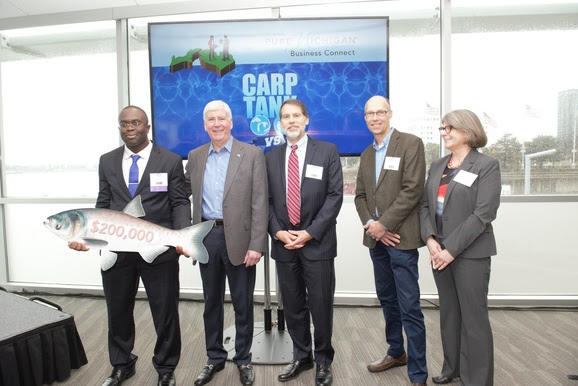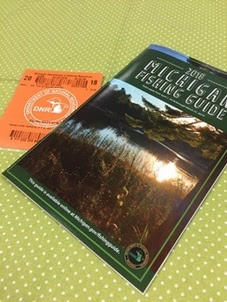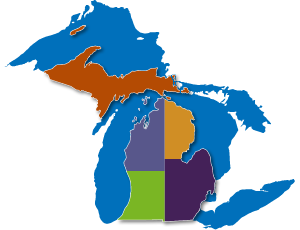Category: Fishing
What Fish See–And What they Don’t

This issue will continue exploring the sight of fish, and provide some practical suggestions for anglers. Underwater, where visibility is usually limited to dozens of feet under even the clearest conditions, there is little need for long-range vision.
Fish have been described as being nearsighted, and can probably focus on objects much closer to their eyes than humans can. Cast a popping bug near a school of bluegill and one of them will often approach within an inch of the lure to inspect it—something that would leave an angler cross-eyed! Even when a fish first detects an object off to the side, it will usually turn and face it in order to examine it. Why? The likeliest explanation is that this brings the object within the narrow range of a fish’s binocular vision.
Unlike humans, many fish have their eyes set far apart on the sides of the head rather than to the front. This allows a very wide arc of monocular side vision for spotting predators or prey, but provides only a narrow range of overlapping binocular vision to the front. There is a blind spot to the rear, and the range of binocular vision to the front encompasses only about 30-45 degrees. For this reason, some experienced anglers believe a fish is more likely to spot a lure if it is cast to the fish’s side instead of directly in front of it. Once a fish spots something, turning to face it undoubtedly gives the fish a better estimate of the object’s distance. Even though fish will turn to examine objects, their eyes do have limited independent movement within the sockets. Like humans, a fish’s eyes move in unison when looking around.

<
A fish has a narrow range of binocular vision to the front, a wide range of monocular vision to both sides, and a narrow blind spot to the back. Read more
Michigan: Weekly Fishing Report
Volunteer to help guard Michigan’s sturgeon

Effort takes place on the Black River in Presque Isle County
The Black Lake Chapter of Sturgeon for Tomorrow in Cheboygan County is seeking volunteers to join in its effort, in partnership with the Michigan Department of Natural Resources’ Law Enforcement and Fisheries Divisions, to help protect lake sturgeon from illegal harvest during the annual spawning run.
Every spring, mature lake sturgeon, a fish species that is threatened in Michigan and rare throughout the United States, become vulnerable to poaching as they briefly leave Black Lake for spawning sites upstream in the Black River. Read more
Michigan: Gov. Rick Snyder awards $500,000 to Carp Tank innovation challenge winners

DETROIT, Mich. – Governor Rick Snyder Tuesday announced the grand prize winner of the Great Lakes Invasive Carp Challenge. The solution proposed by Edem Tsikata, a software consultant at Harvard Medical School in Boston, Massachusetts, received the top award at the Carp Tank competition held Tuesday at the Port Authority in Detroit.
Tsikata’s “Cavitation Barrier to Deter Asian Carp” would utilize a row of specially designed propellers to generate a wall of cavitation bubbles that implode and emit high-speed jets of water. The painful sensation of the bubbles along with the noise of the propellers would repel fish and prevent their passage beyond the bubble barrier. Read more
BoatUS Spring Commissioning Checklist
ALEXANDRIA, Va — With boatyards, backyards, marinas, and clubs now coming to life, spring commissioning time has arrived. Boat Owners Association of The United States (BoatUS) has a Spring Commissioning Checklist to help boaters start the season right: Read more
Michigan: 2018 Fishing License Season Kicks off April 1

For those interested in going fishing in Michigan, a new license is required starting Sunday, April 1. That day is the kickoff to the state’s 2018 fishing license season, as well as the new fishing regulation cycle. All 2018 fishing licenses are good through March 31, 2019.
Anglers have eight options to choose from when making their purchase. All fishing licenses are good for all species.
-
- Resident annual – $26
- Nonresident annual – $76
- Senior annual (for residents age 65 or older) – $11
- 24-hour (resident or nonresident) – $10
- 72-hour (resident or nonresident) – $30
- Resident combo hunt/fish (base, annual fishing, two deer) – $76
- Senior resident combo hunt/fish (base, annual fishing, two deer) – $43
- Nonresident combo hunt/fish (base, annual fishing, two deer) – $266
Michigan: Conversations & Coffee with DNR fisheries staff scheduled throughout state

Those interested in discussing local and statewide fisheries management activities with Michigan Department of Natural Resources staff are encouraged to stop by one of several upcoming “Conversations & Coffee” events taking place around the state this spring.
The DNR Fisheries Division has hosted “Conversations & Coffee” the past few years to give people an opportunity to meet with managers and biologists, discuss local issues and management activities, and get specific questions answered. These meetings are extremely informal; at many of the meetings no formal presentations will be made.
Information on local and statewide regulation changes affecting anglers also will be made available at these meetings. Refreshments will be provided.
Meeting dates, times and locations include: Read more
Zinke Announces More than $1.1 Billion for Sportsmen and Conservation
This year marks $20 billion in hunter and angler conservation funding
HORICON, WI – Yesterday U.S. Secretary of the Interior Ryan Zinke traveled to Horicon, Wisconsin, where he announced more than $1.1 billion in annual national funding for state wildlife agencies from revenues generated by the Pittman-Robertson Wildlife Restoration and Dingell-Johnson Sport Fish Restoration (PRDJ) acts. The Secretary presented a ceremonial check to the Wisconsin Department of Natural Resources for $34,966,603 while visiting the Horicon Marsh State Wildlife Area. State-by-state listings of the final Fiscal Year 2018 apportionments of Wildlife Restoration Program fund can be found here and the Sport Fish Restoration Program fund here. Allocations of the funds are authorized by Congress. To date, the U.S. Fish and Wildlife Service has distributed more than $20.2 billion in apportionments for state conservation and recreation projects.
“American sportsmen and women are some of our best conservationists and they contribute billions of dollars toward wildlife conservation and sportsmen access every year through the Pittman-Robertson and Dingell-Johnson Acts,” said Secretary Zinke. “For nearly eighty years, states have been able to fund important conservation initiatives thanks to the more than $20 billion that has generated nationwide. Every time a firearm, fishing pole, hook, bullet, motor boat or boat fuel is sold, part of that cost goes to fund conservation. The best way to increase funding for conservation and sportsmen access is to increase the number of hunters and anglers in our woods and waters. The American conservation model has been replicated all over the world because it works.” Read more
Researchers to Deploy Wall of Sound to Battle Invasive Fish
FRANKFORT, KY — Researchers will experiment with a riverbed bubbler and sound system as part of the ongoing effort to slow the spread of Asian carp throughout the Mississippi River basin.
European technology originally designed to steer migrating salmon back into main river channels will be tested below Barkley Dam in western Kentucky as an environmentally friendly way to block passage of Asian carp upstream.
The Bio-Acoustic Fish Fence (BAFF) creates a curtain of bubbles, and in conjunction with a powerful sound signal, produces an underwater “wall of sound” designed to deter the passage of fish.
Fish Guidance Systems, LTD, a company based in the United Kingdom, invented the device to herd migrating fish around water intakes and dams in Europe. The company describes the fence as a behavioral barrier that requires less maintenance than a physical barrier, such as a screen or an electrical barrier. Read more


 Southeast Lower Peninsula
Southeast Lower Peninsula Southwest Lower Peninsula
Southwest Lower Peninsula Northeast Lower Peninsula
Northeast Lower Peninsula Northwest Lower Peninsula
Northwest Lower Peninsula Upper Peninsula
Upper Peninsula Great Lakes Temperature Map
Great Lakes Temperature Map